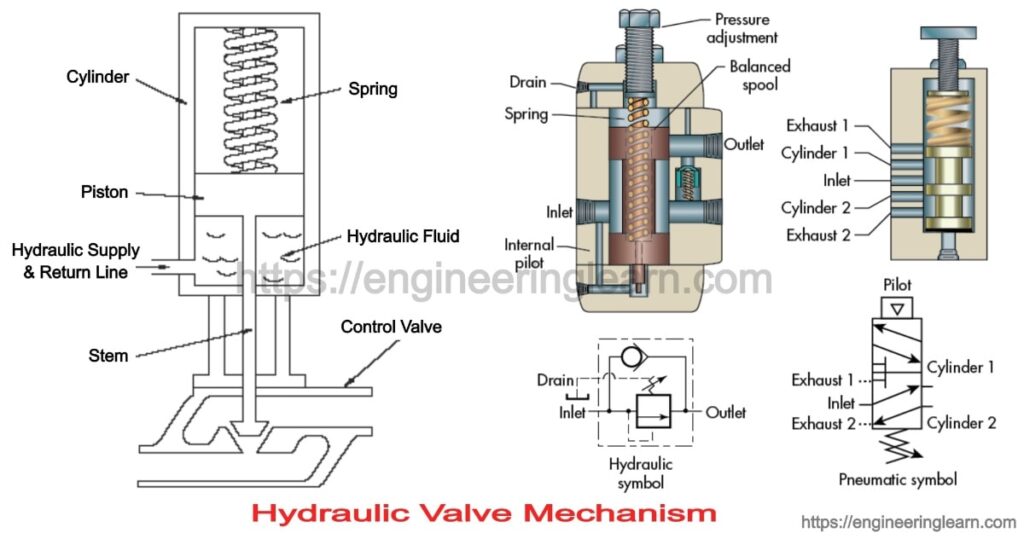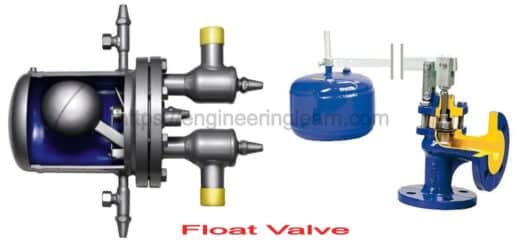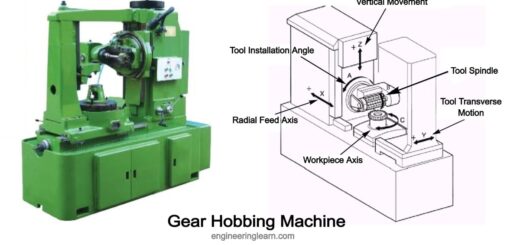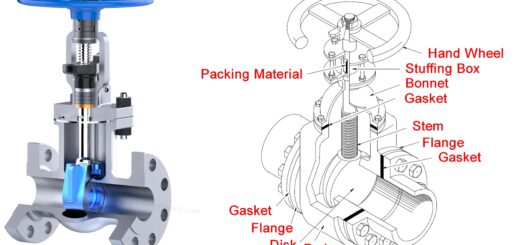Types of Hydraulic Valves

What are Hydraulic Valve?
Types of Hydraulic Valves : Working, Uses, Mechanism, Applications : Hydraulic valves are defined as the mechanical devices which are used to control and regulate the flow of a fluid in hydraulic system, and the direction of flow can be determined by position of the spool. They can be used for completely closing the line in which the fluid is flowing or to redirect the flowing fluid or just to control the level of fluid flowing in a certain area.
They are designed in various styles and they can be controlled mechanically, pneumatically, by hydraulic means, by electric means or manually. These are capable of sustaining high pressure fluids and the pressure of few hydraulic systems can go to as high as 3000 psi. This is why these valves are constructed of iron, steel and other metals which have high strength under pressurized condition operation.
The selection of the valve is done as per the requirements while the size of valve is determined by the maximum flow of fluid in hydraulic system through valve and the maximum system pressure.
Uses of Hydraulic Valves
- Hydraulic valves regulate the flow of fluid through hydraulic systems
- It can be used to switch to required pressure
- It can regulate or restrict the direction of fluid flow
Types of Hydraulic Valves
Hydraulic valves are of various types such as butterfly valve, check valve, relief valve, ball valve, bypass valve, needle valve, regulating valve, diverted. All these types are further classified into three major sub categories, namely:
1. Hydraulic Pressure Control Valves
These valves are used to control and regulate the pressure of fluid which is passing in a Hydraulic system and maintain the required set pressure. The main purpose of providing this valve is to avoid the pressure rise which results in leakage of hydraulic fluid and bursting of pipes. They are also helpful in maintaining a set pressure. In hydraulic systems, there are various types of valve used for pressure controlling operations such as relief valves, counterbalance valves, sequence valves, reducing valves etc.
2. Hydraulic Flow Control Valves
These types of valves are used to control or regulate the flow rate of a hydraulic fluid in a hydraulic system. These valves have adjustable ports which enable them in changing the area of flow which results in change in flow rate through valve. Flow rate in these valves is directly related to the speed of the valves. When the flow rate is reduced then the speed at which the valve is operating is also reduced and vice versa.
The various types of hydraulic control valves are adjustable flow control valve, fixed flow control valves, pressure compensated flow control valves and throttling flow control valves. The method of flow control in these valves varies according to their mechanical design. Flow rate of the fluid can be measured in different ways also. Hence, the selection of suitable types of valves is done on the basis of understanding the flow rate.
Common Types of Hydraulic Control Valves are:
- Deceleration valves
- Priority valves
- Pressure compensated, variable flow valves
- Pressure – temperature compensated, variable flow valves
- Proportional flow control logic valves
- Pressure compensated proportional flow control valves
3. Hydraulic Directional Control Valves
Hydraulic directional control valves are used to regulate the direction of hydraulic fluid in a hydraulic system to different devices according to requirement. They can be used for shifting intermediate state wherein they can control the direction, acceleration or speed of an actuator. A binary valve is simple example of hydraulic directional control valve which can restrict or pass fluid flow.
The check valves, are valves which are used as seal against the seat when a fluid is passing or trying to pass in opposite direction to the desired direction. Some complex hydraulic directional control valves are indicated by standardized numbers which consists of two numerical values like 4/3 or 2/2
In this system the first number indicates number of fluid ports in the valve while the second number states number of valves positions which the valve can achieve (sometime number of the ports are also called as number of ways). So 2/2 represents two port valves which have two positions and 4/3 indicates four port valves which have three positions. In 4/3 valve, the three positions indicates:
- Neutral: No fluid is permitted and all valve port is blocked.
- Extend: Valve routes the fluid to cap end of the cylinder from the hydraulic pump and results in the cylinder to extend.
- Retract: Valve routes the fluid to rod end of the cylinder from the hydraulic pump and results in the cylinder to retract.
Uses of Hydraulic Directional Control Valve
Various hydraulic directional control valves use spool which slides between the passages which is allowing the flow of fluid through open ports, according to the spool position in valve body. Desired port control in valves can be done by using single or multiple spools, and few other control elements like plungers or poppet are used in these valves. Actuator or valve operators are the valve components which move these flow control elements. Actuators provide proper sequencing and timing to the valve position which is required for controlling the hydraulic system.
Actuator mechanism can be pilot actuation, mechanical actuation or electrical actuation. Manual valve controls like pedals, levers or push buttons are included in mechanical actuation but in general automated mechanical devices like rollers, springs, cams, levers are referred.
Pressurized fluid is used in pilot actuation, and fluid assist with moving valve flow control elements. They are used for explosive environment where electrical devices are not used because of high risk of spark causing explosion.
In electrical actuation, solenoids are used which convert electrical signals in form of current supplied to the coil of solenoid into mechanical movement of plunger which generates displacement either linear or rotary. But use of electrical solenoids are limited, combining pilot actuation with solenoid can allow the solenoids to switch low pressure pilot circuit which can be then used for controlling the high pressure ports.
Various Type of Hydraulic Directional Control Valves are:
- Check and non return valves
- Directional poppet valves
- Directional spool valves
Proportional Control Valves
This valve can control opening of fluid flow proportionally instead of gradually.
Types of proportional control valves:
- Proportional directional control valves
- Proportional pressure control valves
- Proportional flow control valves
Image Source :- globalspec, hydraulicspneumatics













